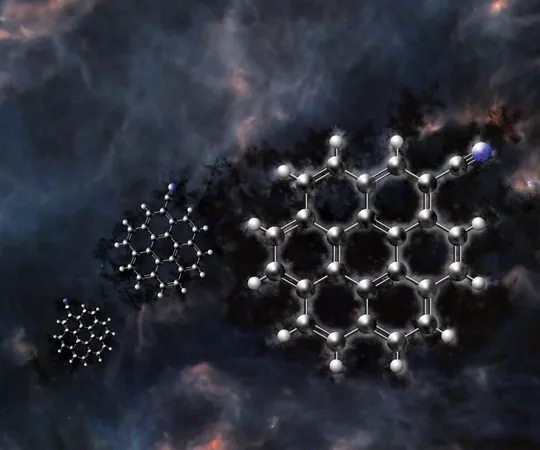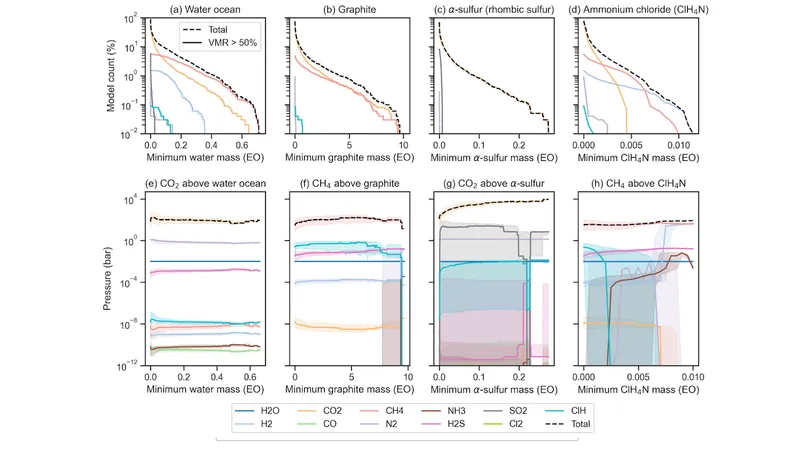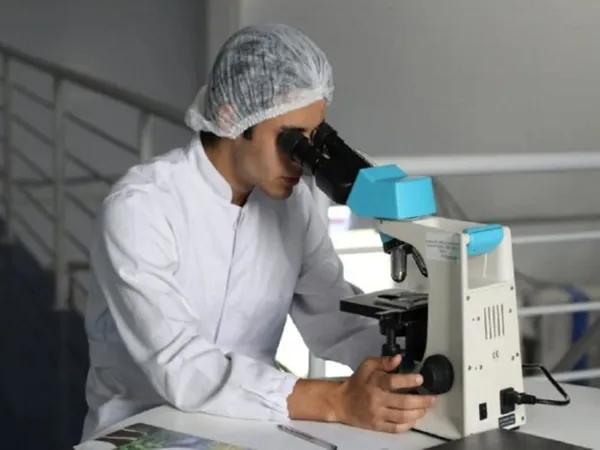
Groundbreaking Discovery: The Largest Aromatic Molecule in Deep Space Revealed!
2025-06-09
Author: Mei
Astronomers Unveil a Cosmic Chemist's Dream
In a stunning revelation within the realm of astrochemistry, a coalition of chemists and astronomers has unearthed cyanocoronene, the most colossal polycyclic aromatic hydrocarbon (PAH) detected in the vastness of space. This intriguing molecule, formed by seven fused benzene rings and a cyano group (C₂₄H₁₁CN), was identified in the cold, shadowy molecular cloud TMC-1, a hotspot for stellar births and chemical diversity.
A Giant Among Molecules
Cyanocoronene is an impressive derivative of coronene, often hailed as the quintessential stable PAH due to its unique makeup. PAHs are thought to harbor a significant portion of the universe's carbon, playing a pivotal role in the cosmic processes that lead to star and planet formation. Previously, only smaller PAHs had been discovered in the granular depths of space, making this newfound giant a monumental breakthrough.
The Stellar Detective Work!
So, how did they pinpoint this massive molecule? The intrepid research team first synthesized cyanocoronene in the lab and catalogued its distinctive microwave spectrum using cutting-edge spectroscopic methods. Equipped with this molecular fingerprint, they embarked on a sweep of the data from the U.S. National Science Foundation's Green Bank Telescope (NSF GBT) as part of the GOTHAM project, designed to search for aromatic molecules in TMC-1. The result? They detected distinct spectral lines of cyanocoronene, achieving an astronomical statistical significance of 17.3 sigma—an exceptional triumph in the detection arena.
A Cosmic Carbon Reservoir?
Now recognized as the largest PAH molecule confirmed in interstellar space, cyanocoronene boasts a core of 24 carbon atoms (excluding the cyano group). Astonishingly, its prevalence mirrors that of smaller PAHs previously noted, defying assumptions that larger molecules would be uncommon. This hints at the possibility that even more intricate aromatic compounds could be commonplace throughout the cosmos.
The Secrets of Cosmic Chemistry
The research dives into quantum chemistry, showcasing that cyanocoronene can form efficiently in the frigid expanse of space via reactions between coronene and the CN radical, circumventing energy barriers that would typically stifle such processes in lower temperatures. This suggests that the intricate chemistry leading to complex organic molecules can transpire even before the birth of stars.
Connecting the Dots in Cosmic Chemistry
The uncovering of cyanocoronene not only advances our understanding of cosmic chemistry but also bolsters the "PAH hypothesis"—the notion that these molecules are the source of enigmatic infrared emission bands permeating the universe. This discovery draws vital connections between interstellar cloud chemistry and the organic materials found in meteorites and asteroids, indicating that the building blocks of life could have originated in similar interstellar environments long before our Sun ignited.
Onward to New Discoveries!
With excitement brimming, scientists are eager to extend their search for larger PAHs and their variants in the cosmos, investigating how these molecules resist and adapt to the harsh conditions found between the stars. Gabi Wenzel, a leading research scientist at MIT and the Center for Astrophysics | Harvard & Smithsonian, emphasizes, "Every new detection edges us closer to unraveling the origins of complex organic chemistry in the universe—and perhaps, the very foundations of life itself."
An Awaited Announcement
This sensational discovery was unveiled during a press conference at the 246th summer meeting of the American Astronomical Society, marking a significant moment in our understanding of the universe. Stay tuned—this cosmic chemistry story is just beginning!



 Brasil (PT)
Brasil (PT)
 Canada (EN)
Canada (EN)
 Chile (ES)
Chile (ES)
 Česko (CS)
Česko (CS)
 대한민국 (KO)
대한민국 (KO)
 España (ES)
España (ES)
 France (FR)
France (FR)
 Hong Kong (EN)
Hong Kong (EN)
 Italia (IT)
Italia (IT)
 日本 (JA)
日本 (JA)
 Magyarország (HU)
Magyarország (HU)
 Norge (NO)
Norge (NO)
 Polska (PL)
Polska (PL)
 Schweiz (DE)
Schweiz (DE)
 Singapore (EN)
Singapore (EN)
 Sverige (SV)
Sverige (SV)
 Suomi (FI)
Suomi (FI)
 Türkiye (TR)
Türkiye (TR)
 الإمارات العربية المتحدة (AR)
الإمارات العربية المتحدة (AR)